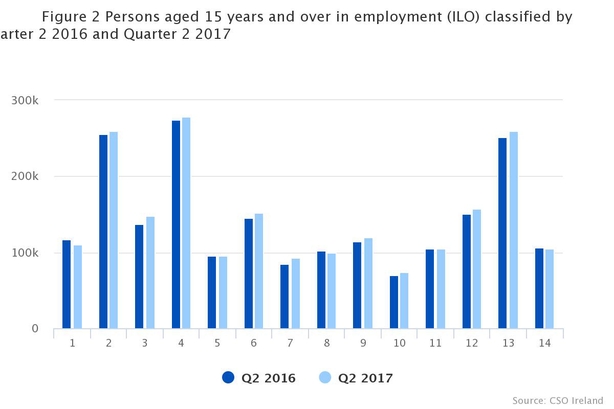New figures from the Central Statistics Office show an annual increase in employment levels in the second quarter, while the level of unemployment fell for the 20th quarter in a row.
The CSO said that employment levels rose by 2.4% in the second quarter of the year, bringing total employment to 2,063,000.
This compares with an annual increase of 2.9% the same time last year and growth of 3.5% in the first three months of the year.
On a quarterly level, employment growth rose by a modest 0.2% in the three month period.
Meanwhile, unemployment fell by 24.7% in the year to the end of June, bringing the total number of people without a job to 141,500.
The seasonally adjusted unemployment rate fell from 6.8% over the quarter to 6.2%
Analysts said that while positive, today's figures were not as strong as had been expected.
Davy's chief economist Conall Mac Coille said this was the slowest pace of expansion in Irish employment for some time and follows a 0.7% gain in the first quarter of 2017, 0.8% in the fourth quarter of 2016
"Given that there has been little evidence of any slowdown in jobs growth from the PMI surveys, Q2's relatively weak employment growth figures are probably just a blip," the economist added.
Today's Quarterly National Household survey from the CSO also shows that the number of people in the labour force in the second quarter of the year inched 0.1% higher to 2,204,500.
The CSO noted that the long term unemployment rate decreased from 4.4% to 3.1% in the year to June.

Long-term unemployment accounted for 48.7% of total employment - the first time since the third quarter of 2010 that long term joblessness has accounted for less than 50% of total unemployment.
And the youth jobless rate decreased from 19% to 16.5% over the year to the second quarter.
Today's figures reveal that the largest rate of increase in employment was seen in the Information and communication sector, with growth of 9.3%, while employment in the construction sector rose by 7.7%.
The biggest drop in the level of employment was seen in the agriculture, forestry and fishing sector, with jobs there down 5.4%.
Commenting on today's figures, Merrion economist Alan McQuaid that there was an average increase in the numbers at work last year of 56,400, up from 49,700 in 2015.
The economist said that the country's employment prospects look very good again in 2017 due to the strong economic recovery, and notwithstanding the Brexit risks.
"Following these latest figures, we are now looking for a net jobs rise of around 48,000 this year. As regards unemployment, we are forecasting an average jobless rate in 2017 of 6.3% as against 7.9% in 2016 and 9.4% in 2015," he added.

